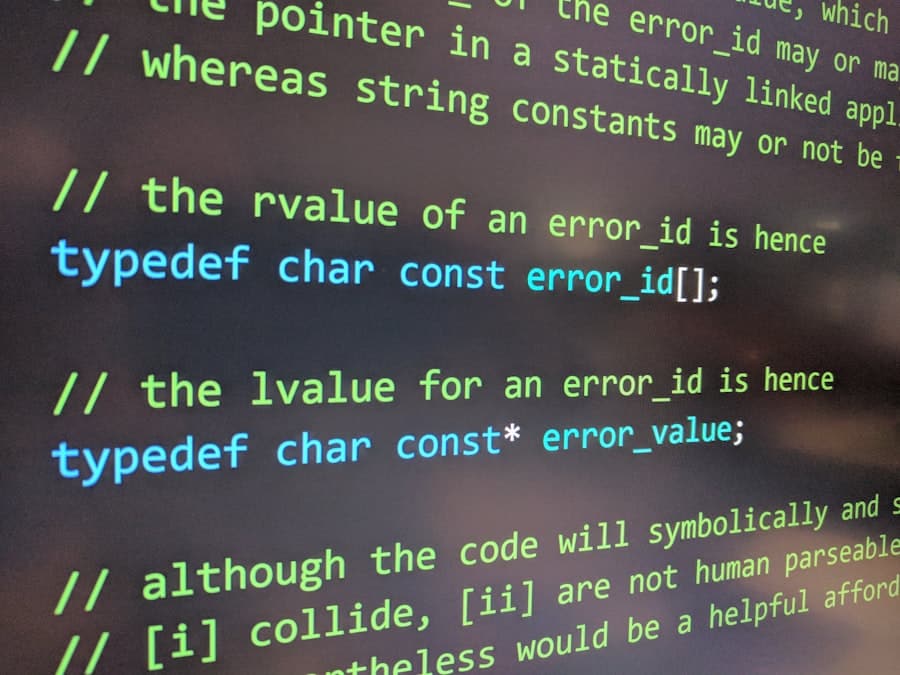In an era where digital transformation is at the forefront of business strategy, the importance of secure coding practices cannot be overstated. As organizations increasingly rely on software applications to drive their operations, the security of these applications becomes paramount. Secure coding practices encompass a set of guidelines and methodologies aimed at preventing vulnerabilities in software development.
These practices are designed to protect applications from threats that could compromise data integrity, confidentiality, and availability. By embedding security into the software development lifecycle, organizations can mitigate risks and enhance the resilience of their applications against cyber threats. The landscape of cybersecurity is constantly evolving, with attackers employing sophisticated techniques to exploit weaknesses in code.
As a result, developers must be equipped with the knowledge and tools necessary to write secure code. This involves understanding not only the programming languages and frameworks they are using but also the potential security implications of their design choices. Secure coding practices are not merely a checklist; they require a cultural shift within organizations where security is prioritized at every stage of development.
This proactive approach can significantly reduce the likelihood of security breaches and foster a more secure digital environment.
Key Takeaways
- Secure coding practices are essential for developing software that is resistant to security threats and vulnerabilities.
- Insecure code can result in significant financial and reputational costs for companies, including data breaches and loss of customer trust.
- Common security vulnerabilities in code include injection attacks, broken authentication, and sensitive data exposure.
- Implementing secure coding practices can lead to improved software quality, reduced security risks, and lower maintenance costs.
- Case studies of companies that have suffered from insecure code highlight the importance of prioritizing security in software development.
The Cost of Insecure Code
The financial implications of insecure code can be staggering. According to a report by IBM, the average cost of a data breach in 2021 was $4.24 million, a figure that has been steadily increasing over the years. These costs encompass various factors, including legal fees, regulatory fines, loss of customer trust, and the expenses associated with remediation efforts.
The repercussions extend beyond immediate costs; they can also result in long-term damage to a company’s reputation and brand equity. Moreover, the cost of insecure code is not limited to direct financial losses.
Organizations may face increased insurance premiums as a result of security incidents, and they may also incur costs related to compliance with regulations such as GDPR or HIPAThese regulations impose strict requirements on data protection and privacy, and failure to comply can lead to hefty fines. Additionally, the time and resources spent on incident response and recovery can divert attention from innovation and growth initiatives. Insecure code not only jeopardizes an organization’s financial stability but also hinders its ability to compete effectively in an increasingly digital marketplace.
Common Security Vulnerabilities in Code

Understanding common security vulnerabilities is crucial for developers aiming to write secure code. One of the most prevalent vulnerabilities is SQL injection, which occurs when an attacker manipulates a web application’s database query by injecting malicious SQL code. This can lead to unauthorized access to sensitive data, including user credentials and personal information.
Another common vulnerability is cross-site scripting (XSS), where attackers inject malicious scripts into web pages viewed by other users. This can result in session hijacking, data theft, or even the spread of malware. Buffer overflows are another significant concern in secure coding.
This vulnerability arises when a program writes more data to a buffer than it can hold, potentially allowing attackers to execute arbitrary code or crash the application. Additionally, improper authentication and session management can expose applications to unauthorized access. For instance, weak password policies or failure to implement multi-factor authentication can make it easier for attackers to compromise user accounts.
By being aware of these vulnerabilities, developers can take proactive measures to mitigate risks and enhance the security posture of their applications.
Benefits of Secure Coding Practices
Implementing secure coding practices offers numerous benefits that extend beyond mere compliance with regulations. One of the most significant advantages is the reduction in security vulnerabilities within applications. By adhering to established guidelines and best practices, developers can create software that is inherently more secure, minimizing the risk of exploitation by malicious actors.
This proactive approach not only protects sensitive data but also enhances user trust and confidence in the application.
When developers prioritize security during the development process, they are more likely to produce robust and reliable applications.
This focus on quality can lead to fewer bugs and issues in production, resulting in lower maintenance costs and reduced downtime. Additionally, organizations that prioritize secure coding are better positioned to respond to emerging threats and adapt to changing regulatory landscapes. By fostering a culture of security awareness among developers, companies can create a more resilient software ecosystem that supports innovation while safeguarding critical assets.
Case Studies of Companies That Have Suffered from Insecure Code
Numerous high-profile cases illustrate the devastating consequences of insecure code. One notable example is the Equifax data breach in 2017, which exposed the personal information of approximately 147 million individuals. The breach was attributed to a vulnerability in a web application framework that Equifax had failed to patch despite being aware of it for several months.
The fallout from this incident was immense, resulting in over $4 billion in total costs for Equifax, including legal settlements and remediation efforts. Another case is that of Target’s 2013 data breach, which compromised the credit card information of over 40 million customers. The breach was traced back to insecure code in Target’s point-of-sale systems, which allowed attackers to gain access through third-party vendor credentials.
The incident not only led to significant financial losses but also damaged Target’s reputation and customer trust. These case studies underscore the critical importance of secure coding practices and serve as cautionary tales for organizations that underestimate the risks associated with insecure code.
Best Practices for Implementing Secure Coding

To effectively implement secure coding practices, organizations should adopt a comprehensive approach that encompasses various strategies and methodologies. One fundamental best practice is conducting regular code reviews and security assessments throughout the development lifecycle. By integrating security testing into the continuous integration/continuous deployment (CI/CD) pipeline, teams can identify vulnerabilities early in the development process and address them before they reach production.
Another essential practice is adopting a principle of least privilege when designing applications. This means granting users only the permissions necessary for their roles, thereby minimizing potential attack vectors. Additionally, developers should utilize secure coding frameworks and libraries that have been vetted for security vulnerabilities.
Leveraging established tools such as static application security testing (SAST) and dynamic application security testing (DAST) can further enhance an organization’s ability to identify and remediate security issues effectively.
Training and Education for Developers on Secure Coding
Investing in training and education for developers is crucial for fostering a culture of security within an organization. Developers should receive ongoing training on secure coding practices, including awareness of common vulnerabilities and how to mitigate them effectively. Workshops, online courses, and certification programs focused on secure coding can equip developers with the knowledge they need to write secure applications.
Moreover, organizations should encourage collaboration between development teams and security professionals. By fostering open communication and knowledge sharing between these groups, organizations can create a more holistic approach to application security. Security champions within development teams can serve as advocates for secure coding practices, helping to bridge the gap between development and security functions.
Conclusion and Call to Action for Companies to Prioritize Secure Coding Practices
As cyber threats continue to evolve and become more sophisticated, organizations must prioritize secure coding practices as an integral part of their software development processes. The cost of ignoring these practices is far too high, both financially and reputationally. By adopting best practices for secure coding, investing in training for developers, and fostering a culture of security awareness, companies can significantly reduce their risk exposure.
It is imperative for organizations to recognize that secure coding is not merely an option but a necessity in today’s digital landscape. Companies must take proactive steps to integrate security into their development lifecycles and ensure that their applications are resilient against potential threats. By doing so, they will not only protect their assets but also build trust with their customers and stakeholders in an increasingly interconnected world.
In today’s rapidly evolving digital landscape, the importance of secure coding practices cannot be overstated. These practices not only protect sensitive data but also save companies millions by preventing costly breaches and downtime. A related article that delves into the impact of emerging technologies on cybersecurity can be found on Wired. This piece explores how advancements in technology are shaping the future of secure coding and the measures companies must take to stay ahead. For more insights, you can read the full article here.
FAQs
What are secure coding practices?
Secure coding practices are a set of guidelines and best practices that developers follow to write code that is resistant to security vulnerabilities and threats. These practices aim to minimize the risk of security breaches and protect sensitive data.
How do secure coding practices save companies millions?
Secure coding practices save companies millions by reducing the risk of security breaches, data leaks, and cyber attacks. By implementing secure coding practices, companies can avoid costly security incidents, legal fees, and damage to their reputation.
What are some examples of secure coding practices?
Examples of secure coding practices include input validation, proper error handling, secure authentication and authorization, encryption of sensitive data, and regular security testing and code reviews.
How do secure coding practices benefit companies?
Secure coding practices benefit companies by reducing the likelihood of security incidents, protecting sensitive data, maintaining customer trust, and avoiding financial losses associated with security breaches.
What are the consequences of not following secure coding practices?
Not following secure coding practices can lead to security vulnerabilities, data breaches, financial losses, legal consequences, and damage to a company’s reputation. It can also result in non-compliance with industry regulations and standards.

